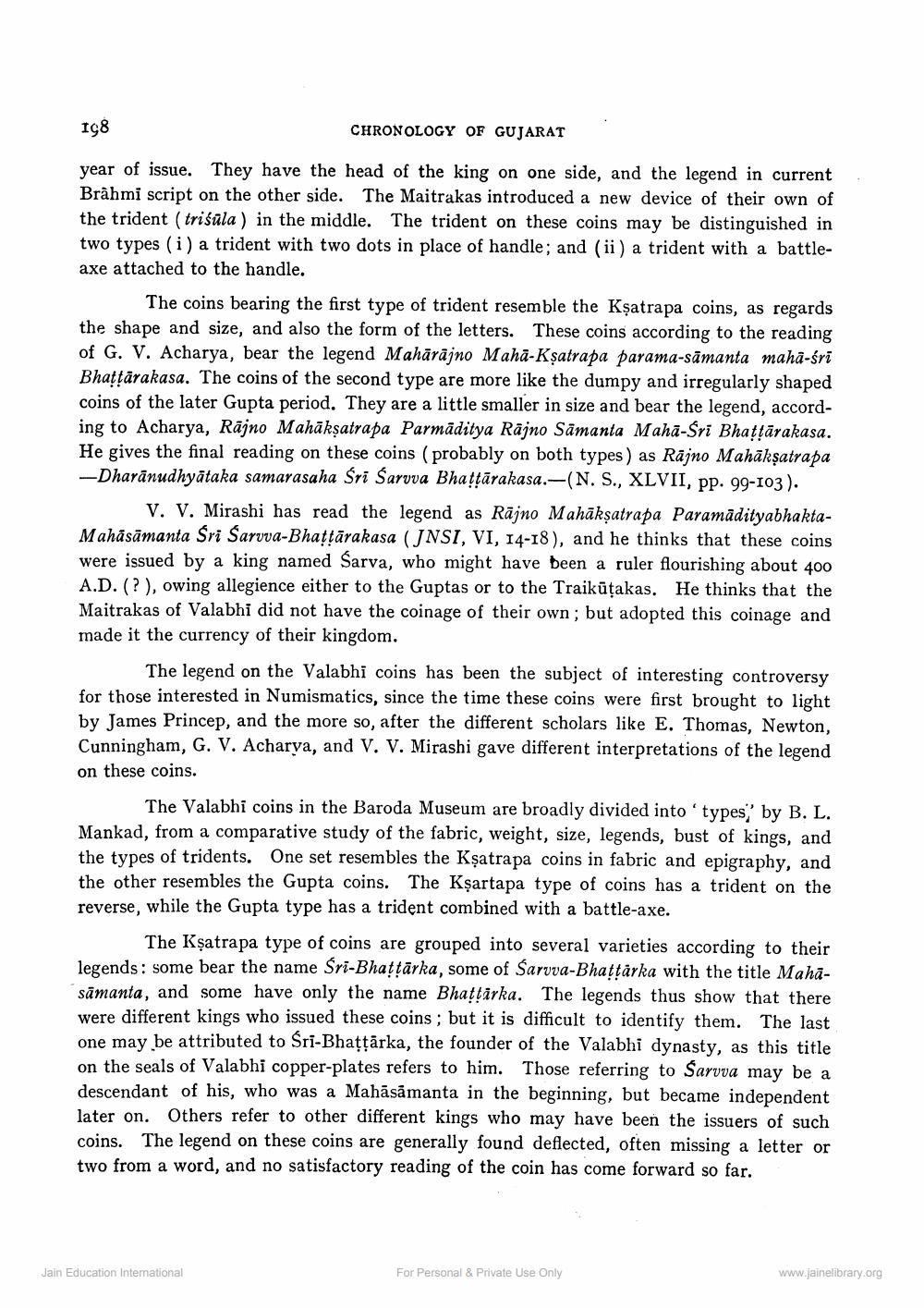________________
198
CHRONOLOGY OF GUJARAT
year of issue. They have the head of the king on one side, and the legend in current Brahmi script on the other side. The Maitrakas introduced a new device of their own of the trident (trisala) in the middle. The trident on these coins may be distinguished in two types (i) a trident with two dots in place of handle; and (ii) a trident with a battleaxe attached to the handle.
The coins bearing the first type of trident resemble the Ksatrapa coins, as regards the shape and size, and also the form of the letters. These coins according to the reading of G. V. Acharya, bear the legend Maharajno Maha-Ksatrapa parama-samanta maha-śri Bhattarakasa. The coins of the second type are more like the dumpy and irregularly shaped coins of the later Gupta period. They are a little smaller in size and bear the legend, according to Acharya, Rajno Mahākṣatrapa Parmaditya Rajno Samanta Maha-Sri Bhaṭṭārakasa. He gives the final reading on these coins (probably on both types) as Rajno Mahākṣatrapa -Dharanudhyataka samarasaha Sri Sarova Bhattarahasa.-(N. S., XLVII, pp. 99-103).
V. V. Mirashi has read the legend as Rajno Mahäkṣatrapa ParamadityabhaktaMahasamanta Sri Sarvva-Bhaṭṭārakasa (JNSI, VI, 14-18), and he thinks that these coins were issued by a king named Sarva, who might have been a ruler flourishing about 400 A.D. (?), owing allegience either to the Guptas or to the Traikuṭakas. He thinks that the Maitrakas of Valabhi did not have the coinage of their own; but adopted this coinage and made it the currency of their kingdom.
The legend on the Valabhi coins has been the subject of interesting controversy for those interested in Numismatics, since the time these coins were first brought to light by James Princep, and the more so, after the different scholars like E. Thomas, Newton, Cunningham, G. V. Acharya, and V. V. Mirashi gave different interpretations of the legend on these coins.
The Valabhi coins in the Baroda Museum are broadly divided into ' types," by B. L. Mankad, from a comparative study of the fabric, weight, size, legends, bust of kings, and the types of tridents. One set resembles the Ksatrapa coins in fabric and epigraphy, and the other resembles the Gupta coins. The Kşartapa type of coins has a trident on the while the Gupta type has a trident combined with a battle-axe.
The Ksatrapa type of coins are grouped into several varieties according to their legends: some bear the name Sri-Bhaṭṭärka, some of Sarvva-Bhattarha with the title Mahasamanta, and some have only the name Bhaffärka. The legends thus show that there were different kings who issued these coins; but it is difficult to identify them. The last one may be attributed to Sri-Bhaṭṭārka, the founder of the Valabhi dynasty, as this title on the seals of Valabhi copper-plates refers to him. Those referring to Sarvva may be a descendant of his, who was a Mahāsāmanta in the beginning, but became independent Others refer to other different kings who may have been the issuers of such coins. The legend on these coins are generally found deflected, often missing a letter or two from a word, and no satisfactory reading of the coin has come forward so far.
Jain Education International
For Personal & Private Use Only
www.jainelibrary.org




